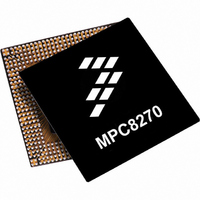MPC8270VVUPEA Freescale Semiconductor, MPC8270VVUPEA Datasheet - Page 13

MPC8270VVUPEA
Manufacturer Part Number
MPC8270VVUPEA
Description
IC MPU POWERQUICC II 480-TBGA
Manufacturer
Freescale Semiconductor
Series
PowerQUICC IIr
Datasheet
1.MPC8270VRMIBA.pdf
(80 pages)
Specifications of MPC8270VVUPEA
Processor Type
MPC82xx PowerQUICC II 32-bit
Speed
450MHz
Voltage
1.5V
Mounting Type
Surface Mount
Package / Case
480-TBGA
Processor Series
MPC8xxx
Core
603e
Data Bus Width
32 bit
Maximum Clock Frequency
450 MHz
Operating Supply Voltage
0 V to 3 V
Maximum Operating Temperature
+ 105 C
Data Ram Size
32 KB
Program Memory Size
16 KB
Program Memory Type
EPROM/Flash
Core Size
32 Bit
Cpu Speed
450MHz
Embedded Interface Type
I2C, JTAG, SPI, UART
Digital Ic Case Style
TBGA
No. Of Pins
480
Rohs Compliant
Yes
Lead Free Status / RoHS Status
Lead free / RoHS Compliant
Features
-
Lead Free Status / Rohs Status
Lead free / RoHS Compliant
Available stocks
Company
Part Number
Manufacturer
Quantity
Price
Company:
Part Number:
MPC8270VVUPEA
Manufacturer:
FREESCAL
Quantity:
105
Company:
Part Number:
MPC8270VVUPEA
Manufacturer:
FREESCAL
Quantity:
748
Company:
Part Number:
MPC8270VVUPEA
Manufacturer:
Freescale Semiconductor
Quantity:
10 000
Part Number:
MPC8270VVUPEA
Manufacturer:
NXP/恩智浦
Quantity:
20 000
4.5 Experimental Determination
To determine the junction temperature of the device in the application after prototypes are available, the thermal
characterization parameter (Ψ
temperature at the top center of the package case using the following equation:
where:
The thermal characterization parameter is measured per JEDEC JESD51-2 specification using a 40-gauge type T
thermocouple epoxied to the top center of the package case. The thermocouple should be positioned so that the
thermocouple junction rests on the package. A small amount of epoxy is placed over the thermocouple junction and
over 1 mm of wire extending from the junction. The thermocouple wire is placed flat against the case to avoid
measurement errors caused by cooling effects of the thermocouple wire.
4.6 Layout Practices
Each VDD and VDDH pin should be provided with a low-impedance path to the board’s power supplies. Each
ground pin should likewise be provided with a low-impedance path to ground. The power supply pins drive distinct
groups of logic on chip. The VDD and VDDH power supplies should be bypassed to ground using by-pass
capacitors located as close as possible to the four sides of the package. For filtering high frequency noise, a capacitor
of 0.1uF on each VDD and VDDH pin is recommended. Further, for medium frequency noise, a total of 2 capacitors
of 47uF for VDD and 2 capacitors of 47uF for VDDH are also recommnded. The capacitor leads and associated
printed circuit traces connecting to chip VDD, VDDH and ground should be kept to less than half an inch per
capacitor lead. Boards should employ separate inner layers for power and GND planes.
All output pins on the MPC8280 have fast rise and fall times. Printed circuit (PC) trace interconnection length should
be minimized to minimize overdamped conditions and reflections caused by these fast output switching times. This
recommendation particularly applies to the address and data buses. Maximum PC trace lengths of six inches are
recommended. Capacitance calculations should consider all device loads as well as parasitic capacitances due to the
PC traces. Attention to proper PCB layout and bypassing becomes especially critical in systems with higher
capacitive loads because these loads create higher transient currents in the VDD and GND circuits. Pull up all
unused inputs or signals that will be inputs during reset. Special care should be taken to minimize the noise levels
on the PLL supply pins.
5 Power Dissipation
Table 7
management is required to ensure the junction temperature does not exceed the maximum specified value. Also note
that the I/O power should be included when determining whether to use a heat sink. For a complete list of possible
clock configurations, refer to
Freescale Semiconductor
provides preliminary, estimated power dissipation for various configurations. Note that suitable thermal
Ψ
T
P
D
T
JT
= thermocouple temperature on top of package
= power dissipation in package
= thermal characterization parameter
T
J
= T
T
+ (Ψ
MPC8280 PowerQUICC™ II Family Hardware Specifications, Rev. 1.8
JT
Section 7, “Clock Configuration Modes.”
JT
× P
) can be used to determine the junction temperature with a measurement of the
D
)
Power Dissipation
13











